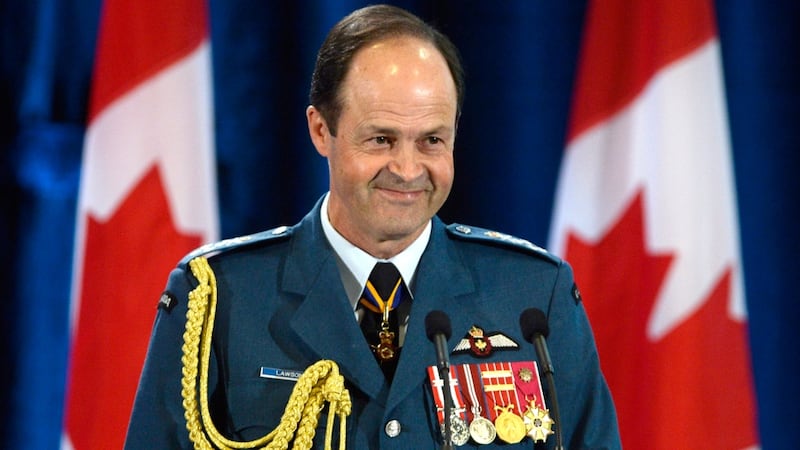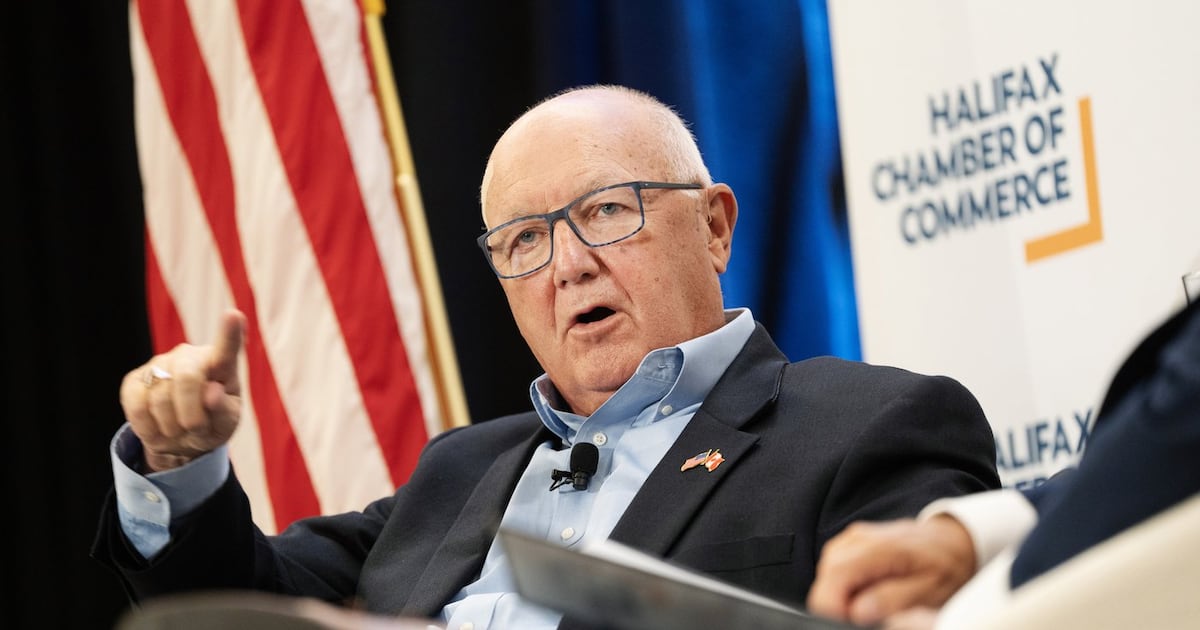Former chief of the defence staff retired Gen. Tom Lawson says Canada isn’t just buying an airplane with it’s purchase of fighter jets, it’s ‘buying a network.’
The U.S. ambassador to Canada invoked the longstanding bilateral defence partnership between Canada and the United States on Wednesday, as Canada considers diversifying its fighter jet fleet procurement.
“On a number of these issues, we’re actually waiting to see exactly where the Canadian government is going to come out on this,” Pete Hoekstra said in an armchair discussion at the 2025 National Manufacturing Conference in Ottawa on Wednesday, when asked about the future of the Canada-U.S.-Mexico Agreement (CUSMA), before pivoting to the American-made F-35 fighter jets.
While Hoekstra insisted that Canada is a “sovereign nation” — and that Ottawa will make up its own mind about the best fighter jet procurement plan — he also raised the F-35 fighter jet program multiple times in his fireside chat.
“The F-35 has been a phenomenal success,” he said, noting that the plane is the product of a U.S.-led international consortium of nations, of which Canada was one of the first to sign on. “It’s not an American plane. It’s an international plane.”
“You’ve got companies in Canada that are learning and developing — and probably contributed to — the development of (F-35) technology that you can use on future products and future efforts,” he added.
The ambassador went on to call the F-35 supply chain “a great example of good coordination.”
“But you know, Canada’s going through a review of their defence industry,” Hoekstra said.
 U.S. Ambassador to Canada Pete Hoekstra poses for a portrait at the U.S. Embassy, in Ottawa, Friday, June 6, 2025. THE CANADIAN PRESS/Sean Kilpatrick U.S. Ambassador to Canada Pete Hoekstra poses for a portrait at the U.S. Embassy, in Ottawa, Friday, June 6, 2025. THE CANADIAN PRESS/Sean Kilpatrick
U.S. Ambassador to Canada Pete Hoekstra poses for a portrait at the U.S. Embassy, in Ottawa, Friday, June 6, 2025. THE CANADIAN PRESS/Sean Kilpatrick U.S. Ambassador to Canada Pete Hoekstra poses for a portrait at the U.S. Embassy, in Ottawa, Friday, June 6, 2025. THE CANADIAN PRESS/Sean Kilpatrick
Canada committed to purchasing 88 F-35 fighter jets from the U.S. manufacturer Lockheed Martin, in a deal inked in 2023 following years of delays.
But, amid rising tensions with the United States, the federal government said in the spring that it was reviewing the deal. Sixteen of the 88 planes, meanwhile, are already in production.
At the same time, a state visit from the Swedish royal family — including King Carl XVI Gustaf and Queen Silvia, plus a delegation of top government officials and industry leaders — is underway, with Canada signalling it may be willing to diversify its fighter-jet fleet by purchasing Gripen fighter jets from the Swedish aerospace and defence company Saab.
Defence Minister David McGuinty said in an interview with CTV Question Period last week that the government is open to purchasing jets from several companies. And, speaking to reporters on Parliament Hill on Tuesday, Industry Minister Melanie Joly called the Saab offer “very interesting,” especially because it comes with the possibility of thousands of jobs here in Canada.
In a statement to CTV News, an executive at Lockheed Martin wrote that the F-35 supply chain also has economic benefits for Canada, and that purchasing fewer than 88 jets will have a negative impact on those benefits going forward.
“To date, over 110 Canadian companies have contributed to the F-35 supply chain with $3.2 million in Canadian components in each jet in the current fleet of more than 1,255 aircraft,” wrote Chauncey McIntosh, the F-35 vice-president and general manager. “That’s before Canada receives its first aircraft.”
“The global F-35 program of record is more than 3,600 aircraft for 20 nations. With approximately 30 active Canadian suppliers today and the continued opportunity to bid on work at best value, we expect to produce over $15.5 billion in industrial value for Canada,” McIntosh also wrote. “That includes current and projected production and sustainment opportunities since 2007 and spanning through 2058.”
Pete Hoekstra The U.S. Ambassador to Canada Pete Hoekstra speaks during an event at the Halifax Chamber of Commerce in Halifax on Thursday, Sept. 18, 2025. THE CANADIAN PRESS/Darren Calabrese (Darren Calabrese/The Canadian Press) Changing F-35 deal could impact Norad: Hoekstra
It’s not the first time Hoekstra has alluded to the Canada-U.S. defence partnership — specifically, the importance of interoperability in that relationship — when speaking about the F-35 review.
In an interview on CTV Power Play with Vassy Kapelos last May, Hoekstra signalled that Norad — the bilateral defence alliance between Canada and the U.S. — could be in jeopardy if Canada reneges on the plan to purchase the remaining jets.
“One of the criteria for Norad is interchangeability and interoperability,” Hoekstra said at the time. “So that would mean that we’re flying the same kinds of planes, we’re using the parts, and it’s all interchangeable, and it’s one system.”
“If Canadians are flying one airplane, we’re flying another airplane, it’s no longer interchangeable,” he added. “And so, that might even threaten Norad without talking about new alliances that promise even more security and safety to our people.”
Gripen ‘uniquely good aircraft’: Swedish minister
In an interview for CTV Question Period on Wednesday, Swedish Defence Minister Pål Jonson told Kapelos the Gripen is a “very agile fighter aircraft,” with a good “lifecycle cost,” adding that his country is looking for a strategic partnership with Canada, not just a buyer for the jets.
“Without going into what should be a Canadian debate, I can say that the Gripen fighter is a uniquely good aircraft, and it’s uniquely good also to be matched against the Russian Air Force capability,” Jonson said.
Jonson also said, however, that the Gripen deal was not the sole motivation for the state visit.
When asked by Kapelos whether the Swedish delegation would be in Canada if not for the likelihood of the Saab deal being finalized, Jonson said: “That’s not what it’s about.”
He said the state visit comes as Canada and Sweden move from being partners, to allies within NATO, which “makes a big difference” for the relationship.
“I want to be clear: this is a decision for Canada, it’s a decision for the Canadian people,” Jonson also said, referring to the fighter-jet decision, specifically. “We stand open, but it has to be Canada who makes the operational requirements you need.”
 Vance replaces Lawson as Chief of Defence Staff FILE – Chief of Defence Staff, General Tom Lawson smiles during a change of command ceremony in Ottawa, Friday, July 17, 2015. (Adrian Wyld / THE CANADIAN PRESS) ‘Enormous’ concerns over mixed fleet: Lawson
Vance replaces Lawson as Chief of Defence Staff FILE – Chief of Defence Staff, General Tom Lawson smiles during a change of command ceremony in Ottawa, Friday, July 17, 2015. (Adrian Wyld / THE CANADIAN PRESS) ‘Enormous’ concerns over mixed fleet: Lawson
In an interview with CTV News on Wednesday, former Chief of the Defence Staff (Ret’d) Gen. Tom Lawson warned of the challenges of a mixed fleet for the Air Force.
“Don’t saddle the Royal Canadian Air Force with two fleets,” said Lawson, also a former fighter pilot. “It’s so enormously destructive.”
Following his retirement from the military, Lawson provided strategic consulting services to Lockheed Martin Canada from 2016 to 2022.
The former chief of the defence staff said the difference between the Gripen — which he called a “lovely aircraft” — and the F-35 in terms of capability is a “big, big deal,” adding the Gripen is “yesterday’s technology tomorrow.”
Factoring in the number of years it would take for pilots, technicians and ground crews to be trained on the Gripen, Lawson said the planes would likely be grounded for at least a decade.
He added that Canada is down to just a few dozen fighter-jet pilots, so to split them between different aircrafts would present major challenges.
“(I have) enormous concern, related to, first of all, the capability of the Gripen, but also to this point of trying to run, in 2030, two very complex air fleets with a shortage of people they’ve got right now,” Lawson said.
He said that if Canada wants to be seen as serious about defence, it’s “absolutely critical” it has the F-35s’ capabilities, which would be a “wartime-capable fleet.”
